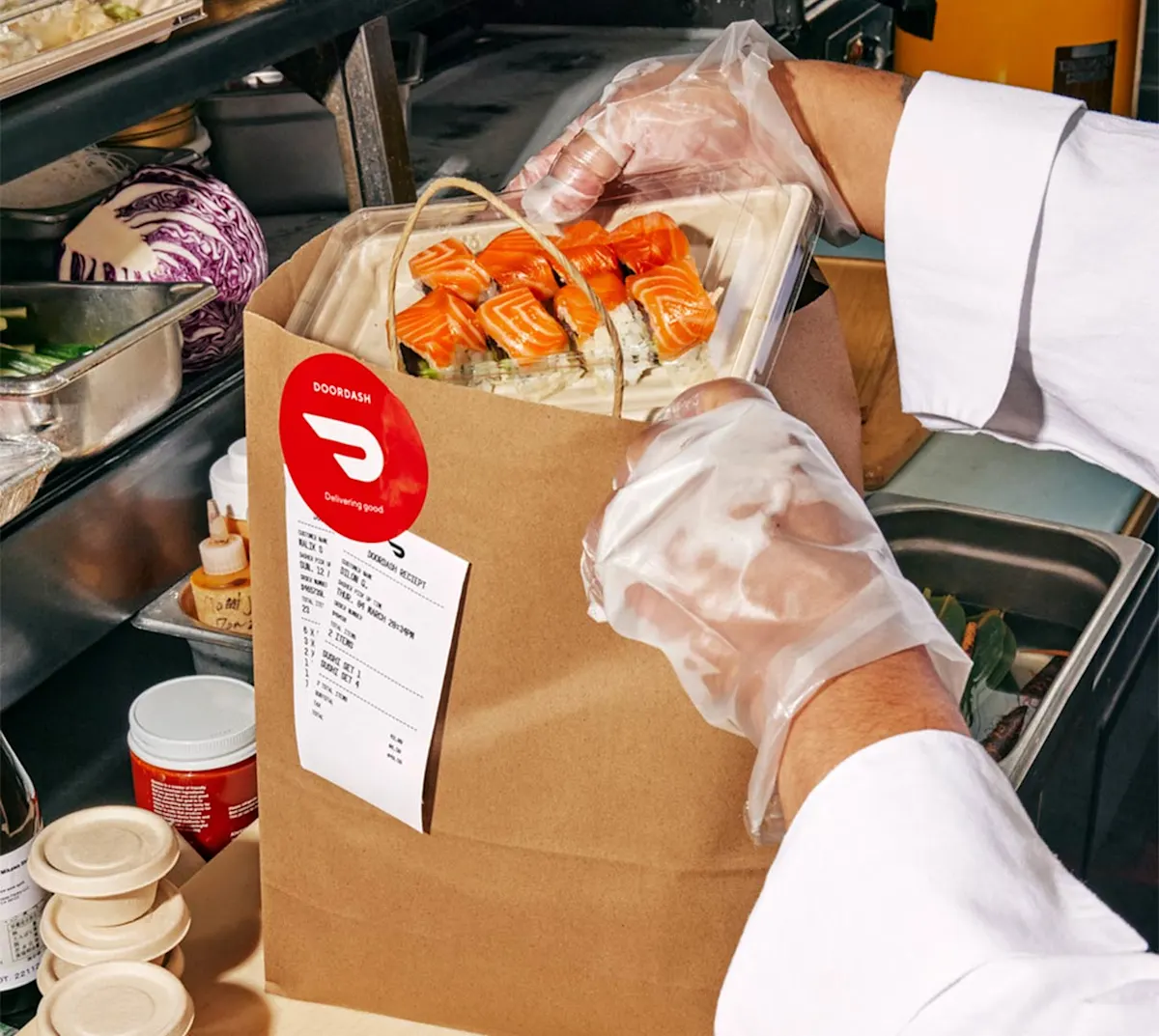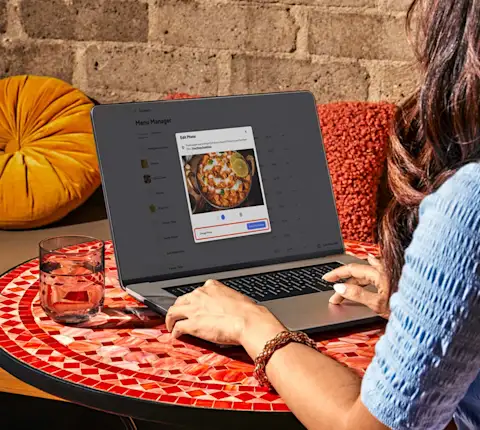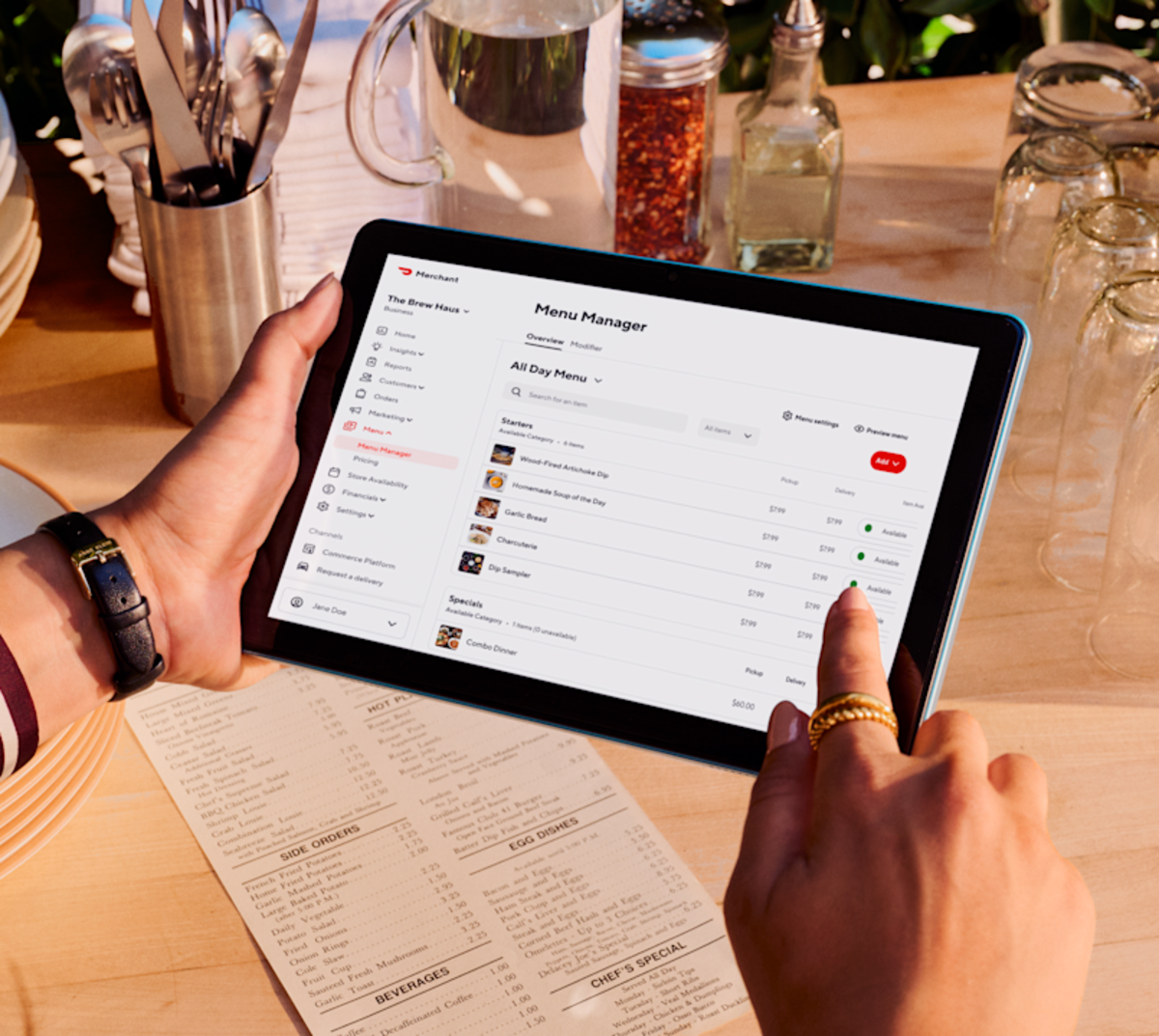Ordering habits, cravings, sustainability priorities, and health preferences are all evolving — shaping how people decide where and what to eat. In a world of TikTok food trends and late-night cravings, food delivery is less of a service and more of a lifestyle.
In 2025, diners continue to support their favorite restaurants — and discover new ones — by ordering takeout or delivery or dining in.
We'll cover a wide range of stats and survey results from the 2025 DoorDash Delivery Trends Report plus other recent industry studies and sources. (Note that stats that do not include source links are from the DoorDash report.)
Download the full reportKeep reading to learn about the latest diner trends and preferences so you can apply them to your business to grow your reach and revenue.
The latest food delivery trends
Food delivery is more popular than ever, blending convenience with the desire for quality meals wherever people are — at home, the office, or on the go. It’s become a core part of how consumers choose to eat. Let's go over some core food delivery industry statistics.
1. The National Restaurant Association reports that more than half (51%) of US consumers believe that ordering delivery and takeout from restaurants is an "essential part of their lifestyle" — and even more Gen Zers (67%) and Millennials (64%) feel this way.
2. According to the same report, 82% of delivery customers say the option to get a daily special, discount, or value promotion is important to them when choosing a restaurant for delivery.
3. 56% of Canadians, 48% of Australians, and 46% of Americans prefer ordering food delivery via third-party apps or websites.
4. And when the food hits the table, the phones stay out. Gen Z are the undisputed rulers of the “scroll-and-snack” — 60% in the US, 46% in Canada, and 41% in Australia say they eat delivery food while looking at their phones.
The latest alcohol delivery trends
5. For 37% of Australians, the top reason for ordering alcohol delivery is the convenience of shopping from home.
6. The alcohol delivery trend is gaining traction in Australia, where 33% of consumers say they’re ordering more than last year. And it’s picking up pace in North America: 40% of Canadian and 42% of US consumers report ordering alcohol for delivery more often now than in 2024.
7. For many, home is where the bar is — 40% of US consumers, 32% of Canadians, and 30% of Aussies order alcohol for regular nights in.
8. Celebrations are key moments for alcohol delivery. Holidays drive 38% of US consumers, 35% of Canadians, and 28% of Australians to order drinks for delivery.
9. Watching sports is another popular occasion — 39% of Americans, 34% of Canadians, and 26% of Aussies order alcohol delivery while enjoying the game.
The latest low- or non-alcoholic drink delivery trends
Demand for low- and no-alcohol drinks is rising fast, with more consumers including these options in their delivery orders.
10. More than half of Australians (52%) who order alcohol delivery have ordered low- and non-alcoholic drinks in the past six months — which jumps to 66% for Gen Zers. That trend is even more pronounced in North America: 76% of Canadians and 80% of Americans who order alcohol delivery have ordered low- or non-alcoholic drinks in the past six months.
11. Nearly a third of consumers feel non-alcoholic drink options are still lacking — 29% of Canadians, 32% of Americans, and 31% of Australians say there aren’t enough choices on restaurant or delivery menus.
A profile of the average delivery customer
Almost anyone can appreciate the convenience of food delivery service and the joy that comes with eating your favorite restaurant's food in the comfort of your own home.
12. People love ordering repeat orders from the same restaurant: 47% of US consumers and 48% of Australians place repeat restaurant orders at least weekly, while 45% of Canadian consumers place repeat restaurant orders at least every two weeks.
13. For many, ordering delivery is more than just convenience — it’s part of their well-being. Nearly three-quarters of Australians (73%) and Canadians (72%), and 78% of Americans consider food delivery as self-care.
14. To get more bang for their buck, diners are saving leftovers from their delivery meals. 52% of Australians, 50% of Canadians, and 51% of Americans ‘always’ or ‘often’ save leftover delivery food for later to make the most of their order.
15. Delivery dinners come with a side of screen time for most — 74% of Aussies, 77% of Canadians, and 86% of Americans tune into TV or movies while they eat.
Restaurant discovery and loyalty trends
16. Influencer impact is growing in the food space, particularly among younger diners. Gen Zers in Australia (22%), the US (20%), and Canada (15%) say they turn to social media influencers when deciding where to order from.
17. In Canada (58%), Australia (53%), and the US (61%), menu selection is the number one factor consumers look at when trying a new restaurant for delivery or pickup, with menu pricing a close second.
18. Another trend that continues to influence diners, especially younger folks, is the popularity of food photography. 46% of US Gen Zers and 41% of US Millennials are swayed by food photos, along with 36% of Canadian Gen Zers and Millennials, and 36% of Aussie Millennials.
19. Customers continue to show a strong interest in loyalty programs which can turn one-time visitors into repeat guests — 78% of customers say they’re more likely to return to a restaurant where they can earn rewards, even if it’s less convenient.
20. Diners don’t stick around for long if you don’t meet their expectations — one-third switched their favorite restaurants in the past year, chasing a better overall experience, especially smoother ordering.
Food delivery routines statistics
Online ordering is making it easier than ever to satisfy cravings fast, with more people ordering frequently and deciding what to eat in minutes — often choosing comfort foods and sometimes even ordering multiple times a day.
21. The online ordering habits that have accelerated in recent years aren’t going away any time soon. One in five US consumers (21%) say they’re ordering delivery more often than they did last year. In Australia, 56% ordered food delivery in the past month — up from 49% last year.
22. In the US, one in four Millennials (27%) have ordered delivery three or more times in a single 24-hour period. In Canada, 27% of the general population has ordered delivery twice in one day, while 13% have done so three or more times in a day. And in Australia, 27% of the general population has ordered three or more times in a day.
23. Meal planning isn’t the norm for most consumers. Just 27% of US consumers, 28% of Canadians, and 29% of Australians say they plan meals days in advance.
24. And hungry minds are made up fast. Half of Canadians (50%) and Americans (49%), and 43% of Australians decide what to order within just 5–10 minutes of opening the app.
25. When cravings call, delivery answers. That’s true for 96% of Canadians, 98% of Americans, and 91% of Australians who’ve ordered food delivery to satisfy a craving.
26. In Australia, 34% of parents admit to giving in to cravings often — compared to just 24% of non-parents. The same trend shows up in Canada and the US. In Canada, 34% of parents often give in to cravings versus 29% of non-parents. In the US, 44% of parents often give in to cravings, compared to 37% of non-parents.
27. Comfort food leads the way in online orders. Australians favor chips, garlic naan, and butter chicken;Canadians also gravitate toward naan and butter chicken, plus miso soup. In the US, french fries, garlic naan, and tacos top the list of most-ordered foods on DoorDash from 2024.
Restaurant delivery statistics
When diners order delivery, how do they order and why?
28. Some diners are getting creative with their delivery meals. Nearly one in five Canadians (17%) have passed off food deliveries as homemade to impress guests or social media. That number jumps to 22% in the US, and a full quarter (25%) of Australians have done the same.
29. Timing matters — and in the US, it’s often a last-minute decision. Three out of four Americans (75%) have ordered delivery on the fly in the past month.
30. Parents feel the crunch even more, with half (50%) ordering last-minute meals weekly, almost double the rate of non-parents. Canadians follow a similar pattern: 63% have ordered last-minute in the past month, and nearly one-third of parents (31%) do so weekly. In Australia, 71% of consumers have ordered last-minute in the past month, with 47% of parents doing so at least once a week.
31. Supporting local restaurants is still popular. Around a third of all consumers — 38% in Canada, 36% in Australia, and 31% in the US — prefer to order from local restaurants (defined as those with just one store in their area).
Food delivery app preferences
Here’s a closer look at how consumers prefer to order their food and what drives their platform choices.
32. In Canada (56%), Australia (48%), and the US (46%), consumers prefer ordering food delivery through third-party platforms like DoorDash.
33. Consumers prefer using third-party delivery apps over ordering directly from restaurants for one main reason: convenience. Ease of use is the top driver for 42% of Australians, 45% of Canadians, and 49% of US consumers.
34. Third-party delivery apps are a regular habit — Canadians use them around 4 times a month, Americans average 4.6 orders, and Australians average 4.2 orders.
Restaurant social media statistics across generations
How do Gen Z, Millennials, Gen X, and Baby Boomers find and interact with restaurants online?
35. These days, it's important for restaurants to have a strong presence on social media. TikTok is the number one app for US Gen Zers (29%) who use social media to look for a new restaurant. In Australia, Facebook is number one among Gen Zers (25%), and in Canada, it’s Instagram (25%).
36. Among Millennial diners using social media to discover new restaurants, Americans (31%), Canadians (21%), and Aussies (21%) prefer Instagram.
37. When it comes to finding new restaurants, Aussies lean on Facebook (21%) more than any other platform. Instagram takes the top spot in Canada (17%) and the US (22%).
38. 67% of Gen Z and 63% of Millennials in the US trust restaurant reviews from social media influencers. But that trust drops significantly among Gen X (45%) and Baby Boomers (28%). In Canada, 62% of Gen Zers and 49% of Millennials trust influencer reviews, compared to 39% of Gen Xers and 20% of Baby Boomers. And in Australia, 77% of Gen Zers and 61% of Millennials trust influencer recs, versus 35% of Gen Xers and 24% of Baby Boomers.
39. In Australia, 84% of Gen Z and 63% of Millennials have ordered a viral menu item for delivery. In the US, 74% of Gen Zers and 69% of Millennials have ordered a trending dish for delivery. In Canada, 72% of Gen Zers have done the same.
Food and drink trends statistics
40. Sustainability matters to Gen Z — 87% in Canada, 92% in the US, and 95% in Australia say it’s an important factor when choosing a restaurant.
41. When US consumers turn to food delivery for guilty pleasures, Gen Xers over-index on pizza, Millennials and Gen Zers can’t say no to fast food, and Baby Boomers are most tempted by dessert.
42. In Canada, Baby Boomers and Gen X stick to pizza when indulging. Millennials crave pizza too, along with chicken and fries, while Gen Z leads in choosing fast food.
43. When it comes to health foods, in Canada, 18% of Gen Zers and 20% of Millennials order non-dairy alternatives, while 27% of Gen Zers choose low-sugar snacks compared to just 18% of the general population. In the US, 37% of Gen Zers opt for non-dairy alternatives and Millennials (20%) are more likely than the general population (15%) to order probiotic and gut-friendly drinks. In Australia, 24% of Millennials and 25% of Gen Zers order low-sugar snacks compared to 21% of the general population, and 23% of Gen Zers opt for bone broth, versus 12% of the general population.
44. On the other side of the coin, Canadian Baby Boomers (75%), Gen Xers (68%), and consumers in suburban areas (64%) are more likely to not have ordered any health-conscious items for delivery. In the US, 62% of Baby Boomers, 60% of Gen Xers, and 55% of consumers in small towns and rural areas say they haven’t ordered health-conscious products for delivery. In Australia, 73% of Baby Boomers, 62% of Gen Xers, and 53% of suburbanites report not ordering health-conscious items.
Restaurant artificial intelligence statistics
Here’s how consumers feel about AI in their dining experiences — from personalized recommendations to trust and privacy concerns.
45. More than half of US consumers (52%), along with 48% of Australians and 43% of Canadians, are comfortable with restaurants and third-party apps using AI to personalize recommendations based on their past orders.
46. In the US, Millennials are the most open to AI-powered restaurant recommendations (60%), followed by Gen Xers (51%), Gen Zers (44%), and Baby Boomers (40%). In Canada, Gen Z is the most open to AI recs (48%), compared to 44% of Millennials, 40% of Gen Xers, and 28% of Baby Boomers. And in Australia, Millennials and Gen Zers are most open (56%), followed by Gen Xers (33%).
47. In the US and Canada, men are twice as likely as women to fully trust AI tools in the kitchen — and in Australia, they’re three times more likely.
48. Privacy is the biggest concern around AI in the restaurant experience for 29% of Canadians and Australians, and 32% of Americans.
Sustainability trends in food delivery
Sustainability is becoming a key factor in how diners choose where to order from, with priorities varying by location and demographics. Here’s what today’s consumers expect when it comes to eco-friendly practices in food delivery.
49. Across Canada (83%), the US (84%), and Australia (87%), the majority of diners say sustainability and ethical sourcing influence where they eat. Gen Z and Millennials in all three countries are even more likely to let these values guide their restaurant choices.
50. Sustainability matters more to parents. In Australia, 13% say it’s very important (vs. 10% of non-parents). In Canada, parents are 67% more likely to say it matters, and in the US, they’re nearly three times more likely.
51. In Australia, urban diners are the most likely to prioritize sustainability (17%), while rural Australians are the least engaged — 1 in 5 say it’s not important at all.
52. If you’re targeting rural Canadian diners, local sourcing matters — 52% rank it as a top sustainability practice that influences their dining decisions. In the US, 36% of diners say it's the restaurant sustainability practice they value most.
How restaurants are bringing consumer insights into their business strategy
As the consumer dining stats above have shown, online ordering has become a normal part of life for the majority of people worldwide. Whether they're ordering to treat themselves, satisfy a craving, or get a great meal on short notice, consumers love to order online, and adding delivery can be beneficial to your restaurant.
In all three of our surveyed regions, delivery apps are the preferred way for consumers to order food from restaurants. By listing your business on the DoorDash Marketplace, and setting up direct delivery and pickup ordering on your website through DoorDash Online Ordering, you can reach new customers who might have never found you otherwise — and turn them into regulars.
Get even more restaurant industry data in the full reports
To learn more about the online ordering landscape and consumer preferences, check out the reports for the US, Canada, and Australia:
US 2025 Restaurant & Alcohol Online Ordering Trends Report
Canada 2025 Restaurant Online Ordering Trends Report
Australia 2025 Restaurant Online Ordering Trends Report
US: Must be 21+ to order alcohol.
CA: Must be 19+ to order alcohol, except where 18+ is permissible in Alberta, Manitoba, and Québec.
AU: Must be 18+ to order alcohol.
Drink responsibly. Alcohol delivery available only in select markets.



